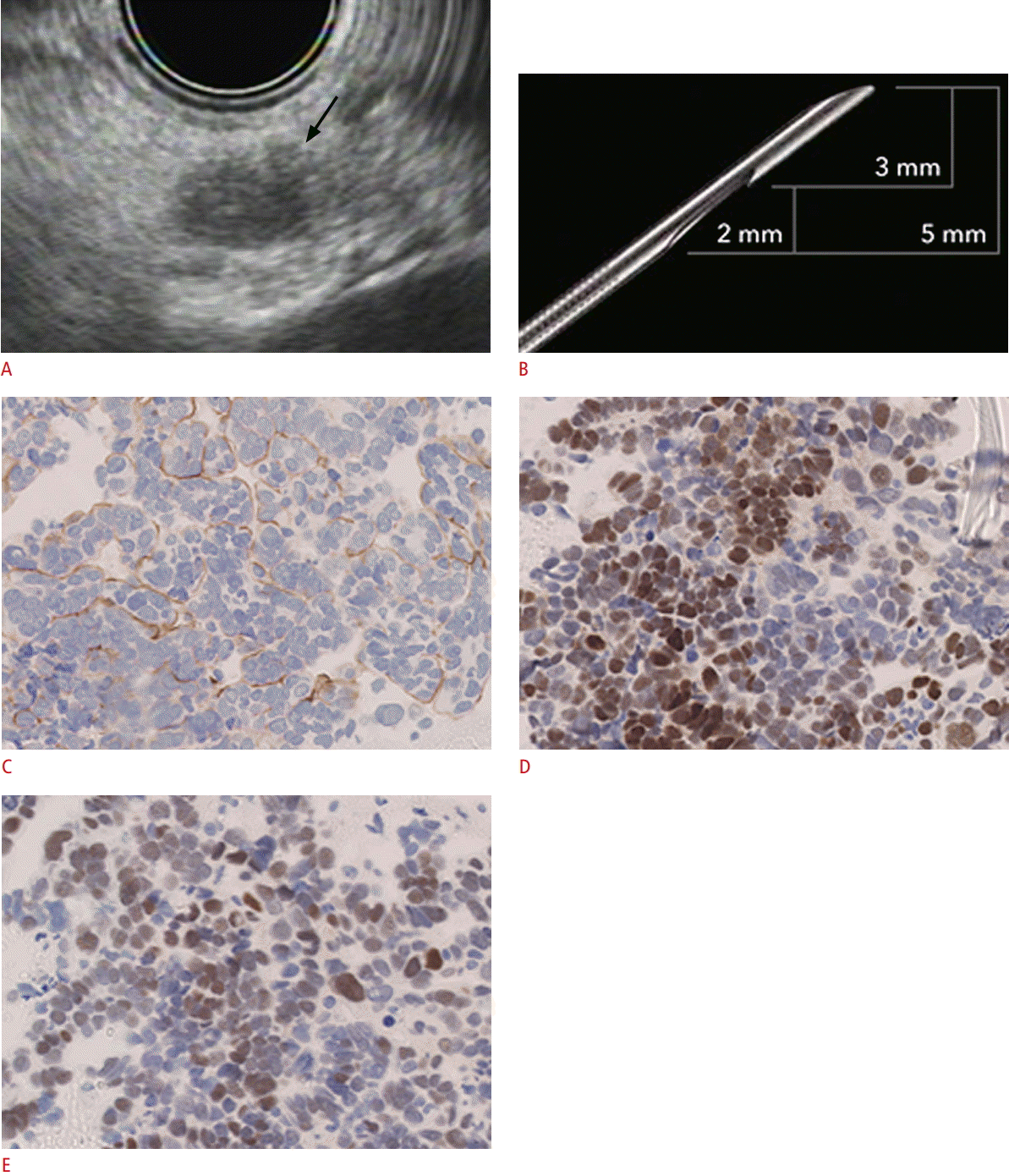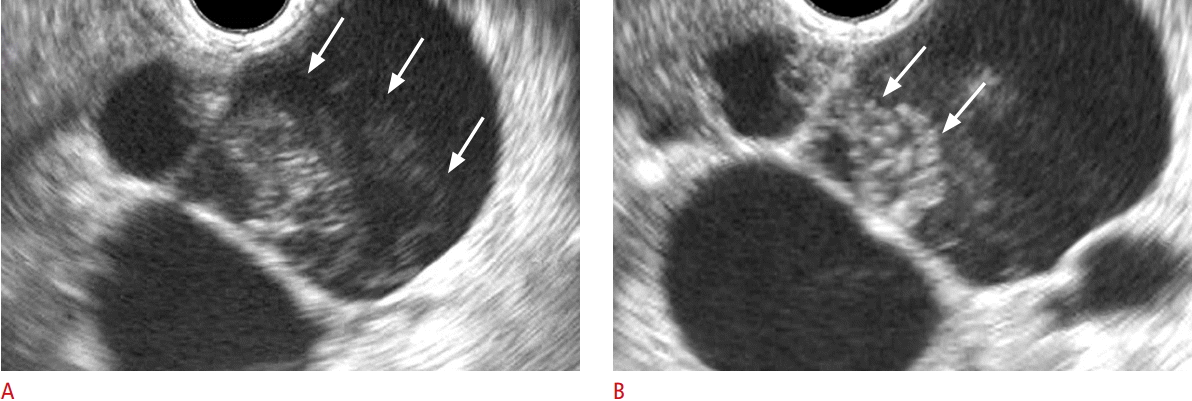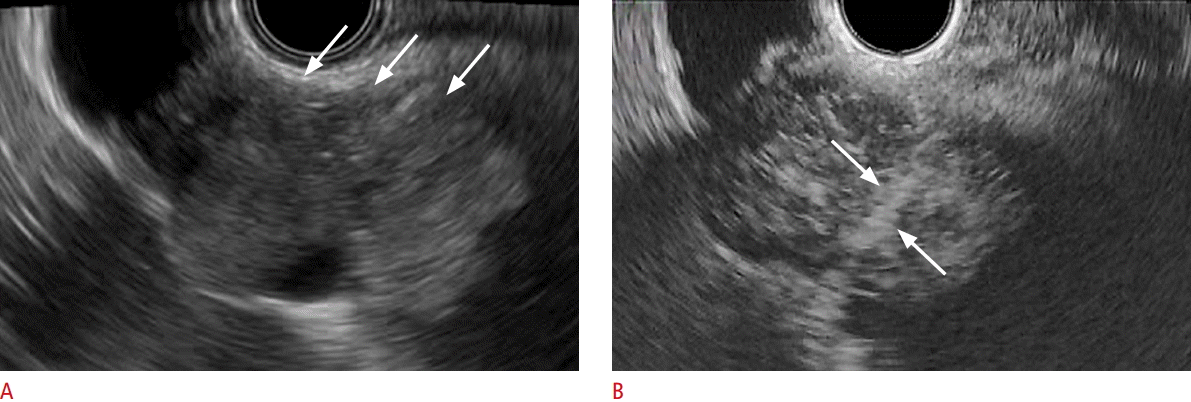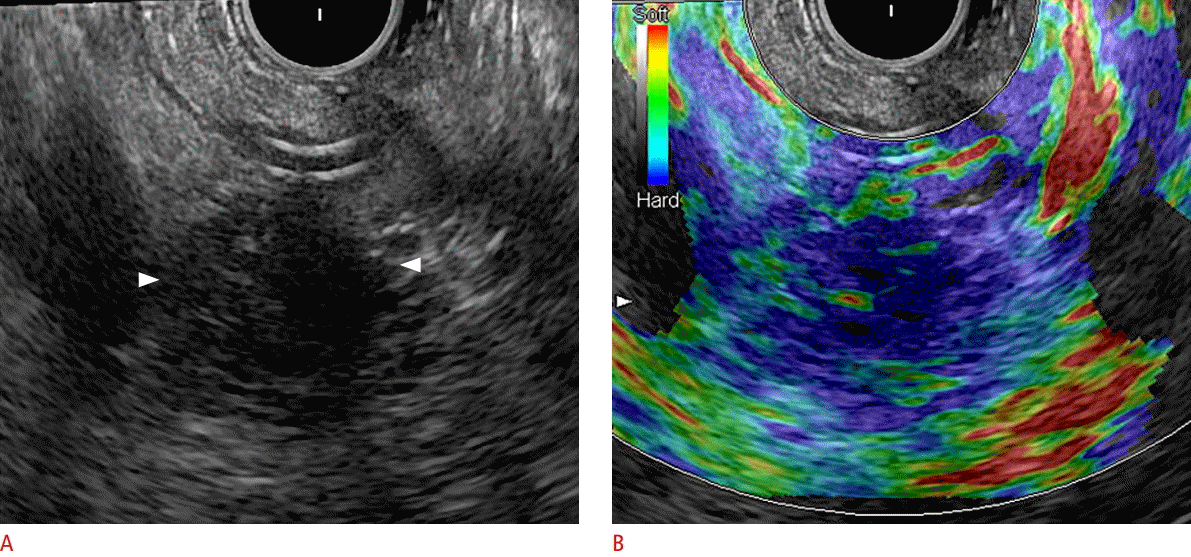Introduction
Endoscopic ultrasonography (EUS) is widely used to evaluate pancreaticobiliary diseases, especially pancreatic masses [1-5]. EUS has an adequate ability to detect pancreatic masses, but it is not sufficient for the differential diagnosis of various types of lesions. A recently published report has shown that when pancreatic carcinoma was defined as a hypoechoic lesion, the sensitivity and specificity of conventional EUS were 86% and 18%, respectively [6]. In order to overcome the limitations of EUS, new techniques, such as contrast-enhanced EUS, EUS elastography (EUS-E), and EUS-guided fine needle aspiration (EUS-FNA) have been developed to characterize the lesions detected by EUS.
EUS-FNA
Solid Lesions of the Pancreas
EUS-FNA was developed for the pathological diagnosis of lesions in and adjacent to the digestive tract and has a diagnostic accuracy of 60% to 90%, depending on the site that is investigated [7]. EUS-FNA is particularly useful for diagnosing pancreatic tumors and assists in making treatment decisions. For these carcinomas, it has a diagnostic sensitivity of 54%-96%, a specificity of 96%-98%, and an accuracy of 83%-95% [8-11]. Various EUS-FNA needles have been developed, including 25-, 22-, and 19-gauge needles. Of particular note, 25-gauge needles are easier to handle and cause fewer complications. Several studies have shown that, in comparison to 22- and 19-gauge needles, 25-gauge needles are more maneuverable and are less likely to yield samples contaminated with blood [12-15]. Additionally, the lesions are more easily penetrated. Moreover, a recently published prospective comparative study showed that 25-gauge FNA needles had a better diagnostic yield in solid pancreatic tumors than 22-gauge FNA needles (pooled sensitivity: 93% for 25-gauge needles vs. 85% for 22-gauge needles) [16]. However, this finding only applied to cytology-based diagnoses, as the 25-gauge needle was inferior to the 22-gauge needle in terms of the accuracy of histology-based diagnoses. In order to improve the diagnostic yield, a histological diagnosis is needed, especially when immunohistological analysis is required (e.g., when a neuroendocrine tumor or malignant lymphoma is suspected). For this reason, a EUS-FNA needle with a core trap was developed recently (Fig. 1) [17-22]. It provides histological core tissue using a 25-gauge needle, even in a single pass, and several studies have shown it to improve the diagnostic yield in solid pancreatic tumors, particularly in the histological diagnosis. Thus, the selection of an optimal FNA needle depends on the purpose of EUS-FNA. The technique used during EUS-FNA is also important for improving accuracy. The fanning technique, which involves sampling multiple areas within a lesion during each pass, was found to be superior to the standard approach because fewer passes were required to establish the diagnosis [23]. The slow-pull technique is a new technique during EUS-FNA procedures. In this technique, after the mass is punctured, the stylet is slowly pulled out without suction [21]. It was found that the slow-pull technique was associated with less contamination with blood and resulted in a higher diagnostic yield when a smaller (25- or 22-gauge) core biopsy needle was used. This pattern was also observed when slow-pull aspiration with a standard 25-gauge EUS-FNA needle was followed by either histological diagnosis or cytology. Thus, many options are available for EUS-FNA, and further study is required to establish the optimal methods for EUS-FNA.
Cystic Lesions of the Pancreas
EUS-FNA is efficient for the differential diagnosis of pancreatic cysts. It also identifies the main pancreatic duct communication by measuring intracystic pancreatic enzymes or tumor markers such as amylase, lipase, and carcinoembryonic antigen (CEA) [24-29]. Brugge et al. [24] reported a 79% accuracy for diagnosing mucinous cystic neoplasms when the cut-off value of CEA was defined as 192 ng/mL. Van der Waaij et al. [25] reported a 98% specificity for identifying mucinous cystic neoplasms as malignant when CEA in the cyst was >800 ng/mL and also indicated that a cyst fluid amylase concentration of <250 U/L virtually excluded the possibility of a pseudocyst. Although EUS-FNA rarely causes complications such as hemorrhage (0.2%-6%) and infection (0.2%-5%), determining how management may be affected by the imaging information is essential before performing EUS-FNA [26-28]. Cyst size is often the most important determinant of success in cyst aspiration and the acquisition of adequate fluid for analysis. Walsh et al. [29] showed that a minimum cyst size of 1.5 cm was needed to obtain at least one variable (cytology, CEA, and amylase) with an 84% success rate, and therefore endorsed using EUS-FNA for pancreatic cysts 1.5 cm or larger. Recently, through-the-needle imaging has been employed for evaluating pancreatic cysts. Needle-based confocal laser endomicroscopy (nCLE) that can be inserted into 19-gauge EUS-FNA needles has been developed to allow observations to be made within the cyst [30,31]. By using nCLE, images of the internal structure of the cyst are obtained, which are similar to histopathological images. This novel technique is expected to be of use for the differential diagnosis of malignant versus non-malignant as well as mucinous versus non-mucinous cystic neoplasms.
Gallbladder Masses
EUS-FNA of gallbladder masses was first reported by Jacobson et al. in 2003 [32]. Although only small case series have been published, the FNA of gallbladder masses has been found to have high sensitivity (80%-100%) and specificity [33-35]. However, the effectiveness of EUS-FNA for the diagnosis of gallbladder tumors is questionable. It is necessary to consider bile leakage and/or seeding related to FNA, although no reports have described severe complications in EUS-FNA for gallbladder tumors.
Contrast-Enhanced EUS
Contrast-enhanced EUS includes contrast-enhanced Doppler EUS and contrast-enhanced harmonic EUS (CH-EUS). Contrast-enhanced Doppler remains limited in terms of real-time vessel imaging due to artifacts such as blooming. CH-EUS selectively depicts harmonic components that are integer multiples of the fundamental frequency [36,37]. When microbubbles oscillate or are broken after receiving a certain range of acoustic power, harmonic components are produced. The harmonic component derived from microbubbles is higher than that obtained from tissues; thus, contrast harmonic imaging depicts signals from the microbubbles with greater intensity than it depicts signals from the tissue by selectively detecting the harmonic components [36,37]. CH-EUS is a new imaging modality that uses an ultrasonographic contrast agent to visualize blood flow in fine vessels.
Solid Lesions of the Pancreas
On CH-EUS, solid pancreatic lesions can be classified into four patterns depending on the enhancement pattern: non-enhancement, hypoenhancement, isoenhancement, and hyperenhancement [6,38-40]. Pancreatic carcinomas possess a certain degree of enhancement, mostly hypoenhancement, whereas benign necrotic tissue does not exhibit enhancement (Fig. 2, Video clip 1). In contrast, most neuroendocrine tumors exhibit hyperenhancement (Fig. 3) [6,38-40]. A recently published meta-analysis has shown that when pancreatic adenocarcinomas were diagnosed based on showing hypoenhancement in CH-EUS, the pooled diagnostic sensitivity and specificity were 94% and 89%, respectively [41]. When CH-EUS was compared to conventional EUS in detecting pancreatic carcinomas, the former (with pancreatic carcinomas defined as hypoenhanced lesions) had better sensitivity and specificity than the latter (96% vs. 86% and 64% vs. 18%, respectively) [6]. Moreover, CH-EUS clearly depicts the outline of ductal carcinomas, even when the conventional EUS finding is uncertain. This could help clarify the location of the target tumor for performing EUS-FNA. CH-EUS and contrast-enhanced computed tomography (CT) are comparable in terms of differentiating pancreatic carcinomas from other masses. However, for small carcinomas (≤2 cm), CH-EUS was found to be superior (sensitivity, 91%; specificity, 94%) in comparison with contrast-enhanced CT (sensitivity, 71%; specificity, 92%) [38]. This shows that CH-EUS is useful for characterizing small neoplasms that contrast-enhanced CT cannot identify. The combination of CH-EUS and EUS-FNA is useful for accurately diagnosing pancreatic cancer. When ductal carcinomas were defined as tumors with hypoenhancement on CH-EUS and/or a positive EUS-FNA result, the sensitivity and specificity were 100% and 92.6%, respectively [38]. Combining CH-EUS with EUS-FNA increased the sensitivity of EUSFNA from 92.2% to 100%.
Cystic Lesions of the Pancreas
Internal structural features of cystic tumors, including the locularity, cystic component, appearance, and/or the presence of a thick wall and/or mural nodules are important in the differential diagnosis of cystic lesions of the pancreas [42,43]. CH-EUS may also aid in the diagnosis of pancreatic cysts through the assessment of the vascularity of structures such as the cyst wall, septa, or mural nodules, as well as by distinguishing contrast-enhancing mural nodules from non-enhancing mucus clots (Figs. 4, 5, Video clip 2) [37]. It is important to evaluate mural nodules in intraductal papillary mucinous neoplasms in order to perform a differential diagnosis of malignant versus non-malignant. However, standard EUS may misdiagnose mucus clots as mural nodules; therefore, confirming the presence of vascularity in the mural nodule on CH-EUS is important and helps to avoid unnecessary surgical resection. Several studies have evaluated the vascular patterns of mural nodules. Ohno et al. [44] classified mural nodules into four groups based on vascularity (low papillary nodules, polypoid nodules, papillary nodules, and invasive nodules) using contrast-enhanced Doppler EUS, and reported that papillary and invasive nodule patterns were associated with malignancy. Kurihara et al. [45] evaluated the vascularity of mural nodules measuring more than 10 mm using transabdominal ultrasonography and reported that a branch-shaped pattern was associated with carcinoma.
Gallbladder Lesions
Hirooka et al. [46] first reported the usefulness of CH-EUS using sonicated albumin for the diagnosis of gallbladder lesions in 1998. The authors reported that the accuracy of the determination of tumor invasion for conventional EUS was 78.6%, whereas it was 92.9% for CH-EUS. Imazu et al. [47] reported that an inhomogeneous enhancement pattern on CH-EUS for wall thickening of the gallbladder indicated malignancy. They evaluated CH-EUS using a Sonazoid and reported that the sensitivity, specificity, accuracy, positive predictive value, negative predictive value, and area under the receiver operating curve (ROC) of CH-EUS were 89.6%, 98%, 94.4%, 97.7%, 92.2%, and 0.94, respectively. These values are superior to those of conventional EUS. With respect to gallbladder polyps, the presence of irregular intratumoral vessels or perfusion defects seen on CH-EUS was a sensitive and accurate predictor of malignant gallbladder polyps [48]. In that study, it was found that in 93 patients with gallbladder polyps larger than 10 mm in diameter, an irregular vessel pattern determined by CH-EUS aided in the diagnosis of malignant polyps, with a sensitivity and specificity of 90.3% and 96.6%, respectively. The presence of perfusion defects was able to diagnose malignant polyps with a sensitivity and specificity of 90.3% and 94.9%, respectively. Thus, malignant gallbladder lesions can be characterized as showing inhomogeneous enhancement and/or irregular vessels on CH-EUS (Fig. 6). In another small series, Park et al. [49] found that CH-EUS also helped differentiate cholesterol polyps from gallbladder adenomas. They studied 87 patients with gallbladder polyps and found that the sensitivity and specificity of CH-EUS for the differential diagnosis of gallbladder adenomas from cholesterol polyps based on the enhancement pattern were 75.0% and 66.6%, respectively. CH-EUS may be useful for the differential diagnosis of gallbladder lesions, but the clinical efficacy of CH-EUS in deciding on a treatment strategy remains questionable. Moreover, the visual assessment of CH-EUS images is subjective and an additional quantitative analysis is required.
EUS Elastography
The major principle of tissue elastography is that a compressive force is applied to the tissue, causing axial tissue deformation (strain), which is then calculated by comparing the echo sets before and after the compression [50]. EUS-E is an adjunctive imaging technique that allows the tissue elasticity of a solid mass to be assessed during a conventional EUS examination [51,52]. This technique allows the direct visualization of information reflecting strain superimposed on the fundamental B-mode image as a strain distribution map (the elastogram), which, for visualization purposes, is color-coded and displayed next to the fundamental B-mode image on the screen. Red is used for encoding soft tissue, blue for hard tissue, and yellow/green for tissue of intermediate stiffness (Fig. 7). Several different variables have been used in EUS-E as a measure of tissue elasticity, color patterns and strain ratio (SR), using analytical techniques such as hue-histogram analysis, and artificial neural networks [52-55]. The classification of color patterns, which is qualitative, may be limited by its subjectivity, which could lead to differences in interpretation between endosonographers. This is less likely to be a significant problem for the remaining three quantitative variables, which are supplementary to the qualitative variable.
Diagnosis of Malignant Pancreatic Lesions
The primary aim of EUS-E is to distinguish benign and malignant tumors through the assessment of tissue elasticity (with benign tumors being soft while malignant tumors are hard) [56]. The first clinical experience with the qualitative analysis of EUS-E was obtained in 49 patients in 2006, and the authors of that study observed an optimal sensitivity (100%) for both pancreatic malignancies and malignant lymph nodes [52]. Iglesias-Garcia et al. [57] extended this type of analysis by using the following four patterns: homogeneous green, heterogeneous green-predominant, homogeneous blue, and heterogeneous blue-predominant. They found that this method diagnosed pancreatic malignancies with a sensitivity, specificity, and overall accuracy of 100%, 85.5%, and 94%, respectively. Two studies have assessed the accuracy of SRbased EUS-E for diagnosing pancreatic malignancies, with the sensitivity ranging from 93% to 100% and the specificity ranging from 17% to 95% [54,58]. Therefore, SR-based EUS-E results are problematically variable, especially with regard to specificity. In 2012-2013, six meta-analyses have been published on this subject. Pei et al. [59] identified 1,042 patients with solid pancreatic masses and found that EUS-E showed a pooled sensitivity and specificity of 95% (93%-96%) and 69% (63%-75%), respectively, with an area under the ROC curve (AUC) of 0.870 for the differential diagnosis of benign and malignant masses. Mei et al. [60] reported similar data in 1,044 cases: for EUS-E, the pooled sensitivity was 95% (94%- 97%), the pooled specificity was 67% (61%-73%), the diagnostic odds ratio was 42.28 (26.90-66.46), and the AUC was 0.905.
Diagnosis of Chronic Pancreatitis
EUS-E is also used for the diagnosis of chronic pancreatitis (CP). Janssen and Papavassiliou [61] compared pancreatic elasticity among healthy patients younger than 60 years of age (group 1) and older than 60 years of age (group 2) with patients with CP (group 3). Histogram analysis of the elastograms (with 0 corresponding to the hardest tissue and 255 indicating the softest tissue) showed that the mean strain values were 110.2±23.9, 80.0±16.4, and 32.4±11.9 in groups 1, 2, and 3, respectively. They identified a cut-off value of 50 that was able to distinguish the presence of CP in contrast to healthy people older than 60 years of age with an AUC of 0.993. These results show that the pancreatic parenchyma becomes significantly harder during aging but remains softer than in patients with CP. Itoh et al. [62] evaluated the ability of EUS-E to quantify the degree of fibrosis of the parenchyma surrounding pancreatic tumors in 58 patients undergoing pancreasectomy. On average, EUS-E (performed through software analysis) showed an AUC of 0.90 for the diagnosis of pancreatic fibrosis. Recently, Dominguez-Munoz et al. [63] enrolled 115 patients with CP undergoing EUS in order to evaluate the correlation between EUS-E and pancreatic exocrine insufficiency (PEI). They observed that pancreatic fibrosis was directly correlated with PEI; in particular, patients with PEI (30% of the study population) showed a significantly higher SR than patients with CP with no PEI (4.89 vs. 2.99, P<0.001). They also estimated that the probability of PEI was <5% in patients with a SR <2.5 and >90% in patients with a SR >5.5.
Biliary Tree and Gallbladder Diseases
Few reports have yet evaluated EUS-E of the biliary tree and gallbladder. Since the common bile duct is a hollow organ, the application of EUS-E may be limited when the bile duct is not completely blocked and the mass does not infiltrate beyond the wall. Rustemovic et al. [64] evaluated EUS-E as a method for screening patients with suspected primary sclerosing cholangitis. They found that a hard or mixed elasticity score was observed more frequently in patients with primary sclerosing cholangitis (P<0.001). According to a recent review article, EUS-E can demonstrate a homogeneously hard (blue) elastographic pattern in malignant masses that infiltrate the bile duct and extend beyond the wall, causing stenosis [65].



 Print
Print facebook
facebook twitter
twitter Linkedin
Linkedin google+
google+







 Download Citation
Download Citation PDF Links
PDF Links PubReader
PubReader ePub Link
ePub Link Full text via DOI
Full text via DOI Full text via PMC
Full text via PMC




